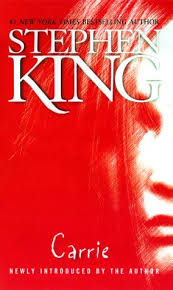
Stephen Kings first and iconic novel, "Carrie", is as much a chilling horror story as it is one about tragic heroes. Heroes may be too broad of a term for the characters of Carrieta White, Tommy Ross, and Sue Snell. Certainly, in the small world of Chamberlain, Maine, they were heroes in their own way.

Carrieta White (or Carrie) was a girl conflicted to belong and to ultimately destroy everything she touched. She was driven to a state of rage over a long period of time after years of bullying from girls at school. Underneath the latent rage was a sweet, vulnerable girl, and at times, a beautiful one, "She felt that her heart would break if he [Tommy] uttered so much as the wrong sound, and if he laughed she would die," (King, 1974, p. 127). None of her classmates would have pegged her as either of those things, but before the terror of prom night came to fruition, Carrie was a shining star, flashing brightly, and fading just as quickly: [Tommy to Carrie] "You're like Galatea [...] We read about her in Mr. Ever's class. She turned from a drudge into a beautiful woman and nobody even knew her," (King, 1974, p. 134). The tragic part of Carrie's character is the betrayal she feels at being humiliated at the prom during the King and Queen coronation, which she and Tommy Ross unexpectedly won. It was not the two buckets of pigs blood that drove Carrie White over the edge; it was the subsequent laughter that followed, largely mixed in with her horror over the sudden death of Tommy Ross.

Tommy Ross could have been pigeon-holed as a jock character, intent on popularity and chasing the hottest girl in school. He was all those things, but with a conscience. Not only did Tommy possess a moral compass, but he also displayed the ability to look ahead, to see past high school: "High school isn't a very important place. When you're going you think it's a big deal, but when it's over nobody really thinks it was great unless they're beered up," (King, 1974, p. 48). That is not to say that Tommy's character was above reproach, because he admitted to doing a despicable thing, possibly to grow closer to Sue Snell, or to put the Carrie White situation in perspective for her. When in seventh grade, Tommy relates how he kicked a bully in the stomach when he had already been passed out on the ground. Clearly, it was a cowardly act, but one he felt was not entirely merit less since his victim was a bully. However, he told Sue, Carrie had never harmed her and her friends, so why oh why pick on her so? Despite his good advice and good intentions, Tommy was the first to die on prom night, thanks to a quarter-full bucket of pigs blood striking him on the skull as it fell to the stage. What was most tragic of all about his character (and for Carrie) was that he had begun to love Carrie, even after knowing her for only a short while. This did not deflect from the love he felt for Sue, it was merely another woman in his life.

Sue Snell was as popular and beloved as Tommy Ross, but not as confident to stand alone in matters when it came to doing the right thing. All that changed after the shower incident with Carrie White. After whole-heartedly taking part in bullying Carrie, Sue felt actual remorse and wanted to make Carrie feel as though she belonged. Sue struggled with this, questioning if she was helping Carrie to abate her feelings of hypocrisy, or if it really was a selfless act. This sort of honest self-analyzation shows a certain maturity and morality in Sue. In the end, she gave up her own prom date (Tommy Ross) for Carrie, an act that had unintended consequences. The tragic part of Sue's character was that she lost her high school sweetheart, and most of her friends in during the hellish prom night.
During the story, King highlights different character perspectives that make for an interesting insight on what people see happening, and what 'really happened'. For example, Carrie reflects on her power as something unknown, and not really evil. Yet, her mother thinks of it as a devilish creation, stemming from the way she saw the power drive her grandmother insane. Also, it is interesting to note that once the blood came down on Carrie, most of the students watching were just as horrified and confused as she was. Really, to break the silence and to keep from going insane, they turned to laughter, and only so because the image of Carrie's bright eyes surrounded by all the red was a comic one. When she tripped on her way off of the stage, the laughter was easier to come by, and when a student tripped her, the laughter positively swelled. To Carrie, once the blood came down, there was silence and then she finally heard the expected laughter. It broke her heart, along with the knowledge that Tommy was dying right next to her. In her grief, she hurried off of the stage, only to stumble slightly. The final cap on the night was when a student cruelly tripped her and she fell to the floor, blood smearing everywhere. She even waited for someone to kick her while she was down, but that did not happen. Perspective is a funny thing, and not one easily written.

